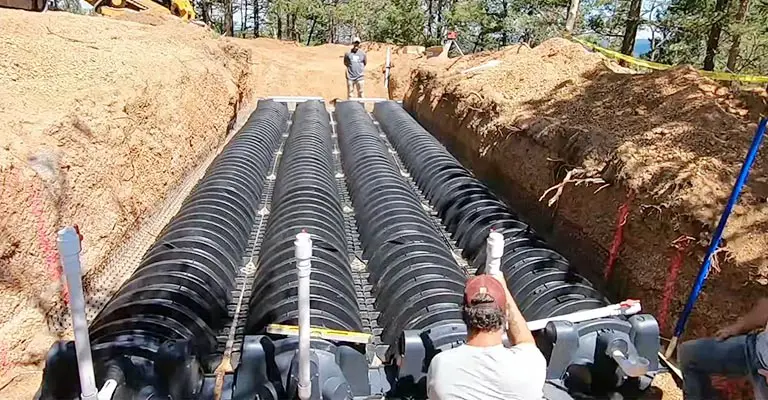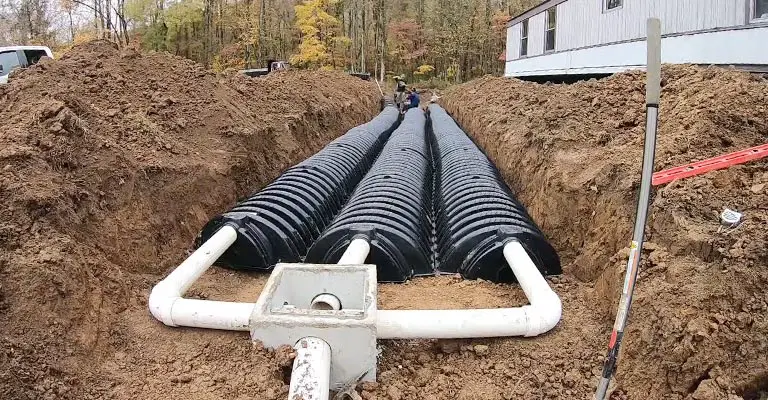A septic system eventually fails and must be replaced. It is possible that you will have limited options when yours fails in the future.
Usually, this is possible from an engineering perspective, but it can be messy and expensive. A lot of soil surrounding the drain field has to be excavated and removed, as well as a portion of the drain field itself.
Consequently, this should be hauled off and disposed of as hazardous waste, and then replaced with proper fill that is engineered and compacted.
In order to establish a new drain field, the soil or area must not have been used previously as a drain field.
If the existing one were dug up, a stench of unbelievable proportions would be released. There is a lot of saturation in the existing soil.
The construction of new homes in my area must include a full-size area reserved for replacement of the septic drain field in the event that it is needed.
You may wish to consult a licensed soil scientist to design a replacement system for your existing system since your property failed a perc test.
Replacement In The Same Spot: Feasibility Analysis
In order to determine whether replacing a leach field at the same location is viable, it must be carefully considered. You need to assess the following:
Conditions Of The Soil:
A new leach field must be compatible with the existing soil. Test the soil to see if it can effectively absorb and treat wastewater. Evaluation of soil permeability, texture, and depth is crucial.
Regulations Local To The Area:
It may be difficult to replace the leach field on the same site if you are required to obtain local permits and regulations for septic system work. Environmental and zoning codes must be followed.
Damage extent:
Examine the existing leach field for damage or issues. It may be possible to correct minor problems, but extensive damage might require a complete replacement.
A Professional Assessment Is Required:
Conduct a thorough evaluation of the site with the assistance of a septic system professional. Replacement feasibility can be determined with their insights.
Leach Field Replacement Steps

In order to succeed in replacing the leach field in the same location, a number of well-defined steps must be followed:
Soil Testing:
Ensure that the soil is suitable for the new leach field by conducting comprehensive soil testing. A system’s design and size are influenced by this.
Permit Acquisition:
In order to comply with regulations, you need to obtain the necessary permits and approvals from the local authorities.
Excavation and Removal:
Ensure that any contaminated materials are properly disposed of after excavating and removing the old leach field components.
New Leach Field Installation:
Follow design specifications and guidelines for optimal performance when installing a new leach field.
Ensure that perforated pipes, gravel or stone fill, and distribution boxes are properly positioned and secured.
Inspection and Testing:
Ensure the new system meets all regulatory and performance standards by inspecting and testing it.
Backfill and Restoration:
The site should be returned to its original condition or landscaped if desired by carefully backfilling the trenches.
The replacement of a leach field at the same location is an involved process that requires meticulous planning and execution.
For a successful septic system replacement that restores your system’s functionality, it is highly recommended to seek the guidance of a septic system professional.
How Cost-Effective Is It To Replace Just The Septic Tank’s Leach Field?

It is important to pump out the tank before replacing the leach field in order to stop the effluent from flowing.
Septic contractors should be scheduled to start immediately after the tank has been pumped since it will be filling up if the house is occupied.
Depending on how many bedrooms there are, the size of the field will vary. It’s fine as long as the tank isn’t cracked or leaking. Roots often clog leech fields. Having replaced two myself, I know what it takes. There was no problem with either tank.
Make sure you check references, speak to 3–4 backhoe/septic contractors, and conduct your own research. If you are not sure what the county recommends/requires, contact or check the county’s web site.
An infiltrator type drain field consists of a plastic tunnel-shaped “pipe” that does not require gravel and is made up of 4-inch perforated pipes and gravel placed in a trench.
There are pros and cons to each. There is a great deal of variation in soil types and how well they percolate. Look for a guy who has knowledge of both. It should only be done once.
Most field failures are not caused by septic tank failures.
However, before you have a contractor come in to work on the field, make sure that the tank has been pumped out and inspected.
Prior to digging up and replacing the field, a legitimate contractor would strongly recommend pumping and inspecting the tank.
An automatic tank replacement due to a leaky leach field is the equivalent of replacing your car’s engine due to a flat tire.
Can My Septic Drain Field Be Restored

In order for your septic system to function properly, you must have a drain field. Septic systems as a whole cannot function properly if there are problems or failures within the field.
You may even lose your whole septic system if there is a problem with the drain field. If your field shows signs of distress, you should take action as soon as possible to restore its full functionality.
If sewer system problems are handled quickly, other costly repairs can be avoided.
Signs Of Drain Field Distress
Whether you were aware of it or not, standing water or sewage on the ground above indicates a problem with your septic system.
The appearance of slime-like substance, often black in color, or even just wet spots on the ground are signs of trouble.
Sewage smells in the area where your drain field is located are also signs that something is wrong. You should also watch out for some other signs of distress.
- To remove all waste from your toilet, you must flush it multiple times. One flush is usually enough to remove everything from the toilet bowl if there isn’t a problem with water levels.
- It’s a red flag if you’re not overfilling your bowl and you have the same amount of water returning to your bowl.
- There is a slow draining problem in your home. There may also be something wrong with your septic system or field if this happens.
- Your drains are backing up with water. It means your system is blocked somewhere when this occurs.
- Your toilet, drains, etc., are making noises. Symptoms such as these indicate that something in your system needs immediate attention.
Consult a professional immediately if you notice any of these symptoms. Waiting too long will increase the cost of the repair.
Drain Field Problems: What Can Cause Them?
Drain field issues are caused by two main factors. Water entering the field in excess is the first problem. A hydraulic overload occurs when this happens.
When humans use too many appliances at once, they can send too much water into the system. A biological overload occurs when your system is overloaded with biological matter.
Some of the worst culprits are garbage disposals. The things we thrash down our drains and flush down our toilets can also overload our systems and cause havoc.
Your drain field can also be affected by nature. Drain fields are frequently affected by tree roots.
The roots of trees can cause a great deal of damage to other structures when they grow into them.
Your field can be disrupted and pipes can be destroyed by these roots. Depending on the location of your field, snowmelt and floods can also hinder absorption.
It is also possible that old age is the cause of the problems in your field. Maintaining your septic system properly can extend its lifespan by more than 20 years.
But even the best care cannot reverse the effects of time. It may be the age of your field that is causing the problem.
Can You Restore An Ailing Drain Field?
Most drain fields can be brought back to life. In order to accomplish this, you can use a few different methods.
- Cleaning your pipes and tank by jetting involves blasting water through them to remove any sludge and blockages.
- In order to restore chemical imbalances in soil, additives can be added to the ground.
- You can use Terralift to help push air into the soil and restore function to your field.
- Your field can be equipped with cleanouts and vents that alert you if there is a clog or a backup.
- A new field will be needed if old age is the cause.
Final Words
In some cases, it is possible to replace a leach field in the same spot, particularly if there is sufficient space and the local regulations permit such an approach.
However, this feasibility depends on various factors such as the condition of the existing leach field, the type of soil, the level of saturation, and local building codes.
Prior to any decision, it is crucial to consult with a professional in the field of septic systems to assess the viability of this option and ensure compliance with all relevant regulations.








